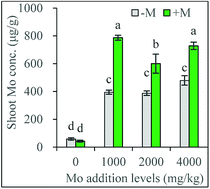Arbuscular mycorrhizal inoculation increases molybdenum accumulation but decreases molybdenum toxicity in maize plants grown in polluted soil†
Abstract
Molybdenum (Mo) is an important micronutrient required by both plants and microorganisms, but may become toxic when presents in excess concentration. However, Mo toxicity in soil-plant systems as influenced by arbuscular mycorrhizal (AM) fungi (AMF) still remains unknown. Here, a pot culture experiment was conducted to study the effects of inoculation with Claroideoglomus etunicatum BEG 168 on the growth and Mo content of maize plants growing in soil supplemented with different levels (0, 1000, 2000, and 4000 mg kg−1) of Mo. Results show that the added Mo had no significant effects on AM colonization rate, which ranged from 77% to 92%. Mo addition decreased plant dry weights and leaf pigment contents, as well as nutrient uptake of P, N, Fe, Mg and Cu in shoots and roots, and in most cases, the highest level (4000 mg kg−1) showed the most inhibitory effects. Overall, AM inoculation enhanced plant growth, mineral nutrient uptake, leaf pigment contents and photosynthetic rate under all Mo addition levels. Mo concentrations in plants without Mo addition ranged from 13.1 to 40.1 mg kg−1 in roots, and from 42.8 to 58.4 mg kg−1 in shoots. Addition of Mo increased Mo concentrations in both shoots and roots of all the plants, but showed no significant dose-dependent effects. In non-inoculated plants receiving Mo addition, Mo concentrations were not lower than 400 mg kg−1 in shoots and higher than 1300 mg kg−1 in roots respectively. AM inoculation further enhanced Mo concentrations in shoots and roots, but decreased shoot/root Mo ratio at 2000 and 4000 mg kg−1 Mo addition levels. In AM inoculation treatments, soil pH exhibited a decreasing trend with increasing Mo addition level. In conclusion, excess Mo caused toxicity in maize plants, while AM fungus C. etunicatum BEG 168 was tolerant to the added Mo, and could alleviate the Mo-induced phytotoxicity by improving plants' mineral nutrition, leaf pigment contents and photosynthetic properties, and by mediating Mo partitioning in plants and soil pH. Our present results suggest a specific protection mechanism exists in AM plants against excess Mo, and their promising potential in ecological restoration and phytoremediation of Mo-polluted sites.



 Please wait while we load your content...
Please wait while we load your content...